NVIDIA’s GeForce GTX 460: The $200 King
by Ryan Smith on July 11, 2010 11:54 PM EST- Posted in
- GPUs
- GeForce GTX 400
- GeForce GTX 460
- NVIDIA
Crysis: Warhead
Kicking things off as always is Crysis: Warhead, still the toughest game in our benchmark suite.Even 2 years since the release of the original Crysis, “but can it run Crysis?” is still an important question.
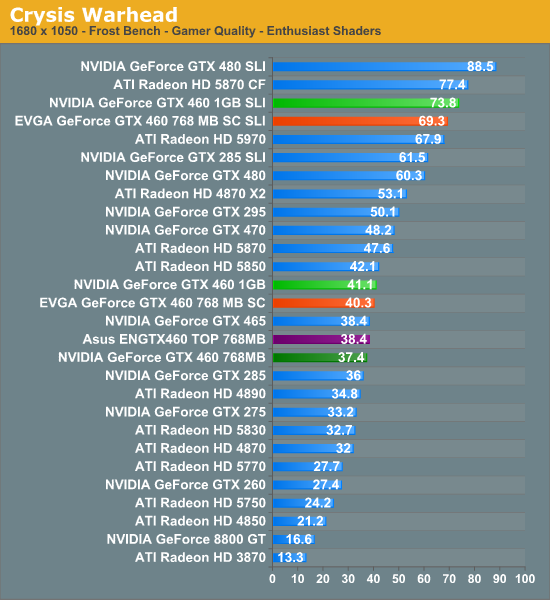
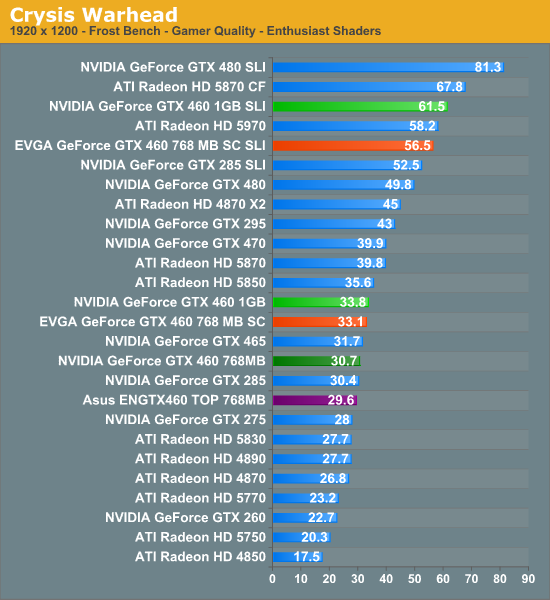
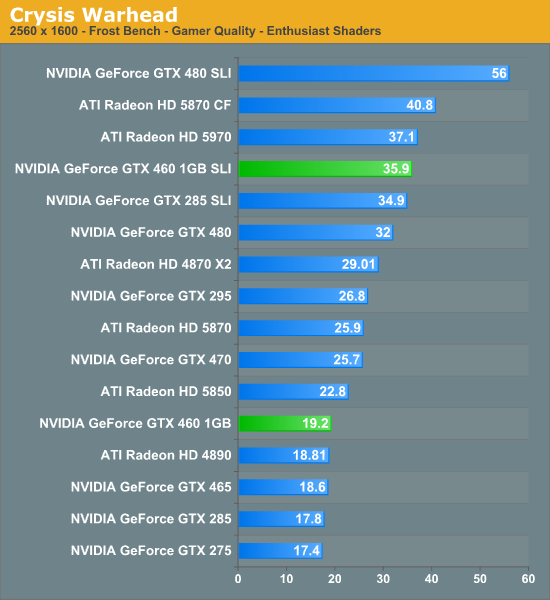
Crysis can be particularly memory-dependent, which in this case highlights the difference between the 768MB and 1GB GTX 460. 2560x1600 is not a viable option on the 768MB card here (or in most other games) due to the lack of VRAM, while at lower resolutions we can still clearly see the impact of having less RAM, less L2 cache, and less ROP power. At both 1680 and 1920, the 1GB GTX 460 is roughly 10% faster than the 768MB card. This much less than the 33% lead the 1GB GTX 460 has in terms of RAM/L2/ROP, but it’s still clear that there is a price to pay on the 768MB GTX 460.
Meanwhile the Radeon 5830 - already a hobbled card due to having half the ROPs of a full Radeon HD 5870 – takes a hard loss here. The 768MB GTX 460 comes ahead at 1920 by roughly 14% even with its RAM disadvantage. AMD definitely has their work cut out for them. As for the Radeon 5850, the 1GB GTX 460 trails right behind it until we hit 2560, where AMD’s continued advantage at high resolutions helps the card pull away some.
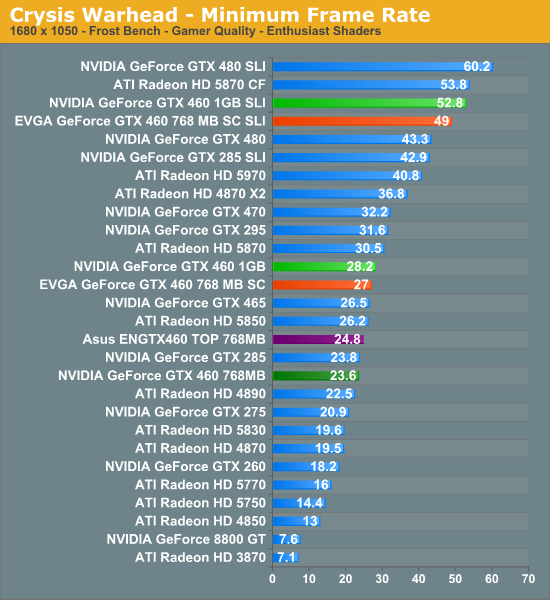

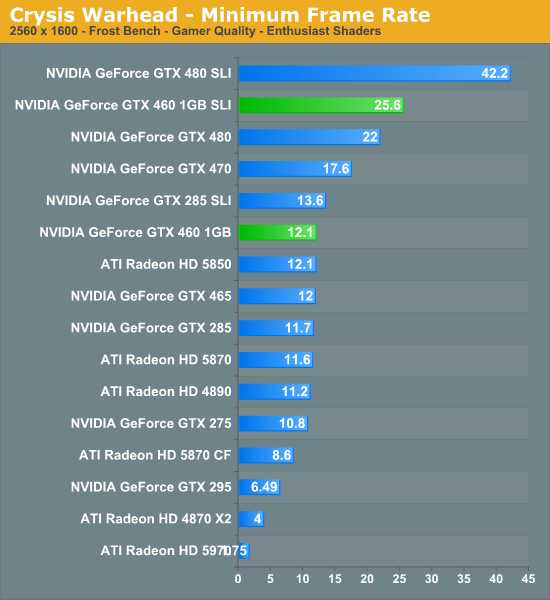
Looking at the minimum framerates, the difference in RAM/L2/ROPs becomes more pronounced. Here the 1GB GTX 460 has a 15% advantage at 1920, and strangely enough even beats a 5850 here. With the greater overhead of SLI this becomes even more of an issue, with our ragtag SLI set of 1GB GTX 460s beats our pair of factory overclocked EVGA 768MB GTX 460s by 33%. Finally the 5830 fares even worse, losing to the 768MB GTX 460 by 35%. In Crysis there is no substitute for more RAM and more ROPs.










93 Comments
View All Comments
GeorgeH - Monday, July 12, 2010 - link
I actually think it should be called a 460. People with a reasonable amount of tech knowledge are going to know the difference, and people without it are already trained to think that a bigger RAM number is always better (see the tons of "bargain" cards with 1GB+ of slow DDR.)Basically, the performance differential here is already clear from the full product name, and we have one fewer model number muddying a GPU market already overflowing with a ridiculous amount of model names that have identical, nearly identical, or completely misleading performance capabilities relative to other model names.
Daeros - Monday, July 12, 2010 - link
I would agree with you except for the common practice of mfg's doubling up on VRAM. When that happens, there will be 768MB, 1GB, 1.5GB, and 2GB versions, and people will have no idea the 1.5GB will probably be slower than the 1GB version.tigersty1e - Monday, July 12, 2010 - link
This line made me read it twice."This in turn means the blades of the fan sit at the same height as the lip, blocking direct airflow out the back. With this design the card is still exhausting at least some air out of the rear of the card, but it shouldn’t be as much as a fully-open card such as our custom Asus GTX 460."
rear and back are the same thing. I think you meant to say the the cover blocks direct airflow out the front.
Ryan Smith - Monday, July 12, 2010 - link
I define the front of the card to be the side with the display ports, so the cover blocks airflow out of the opposite end, the back.fausto412 - Monday, July 12, 2010 - link
While a very nice card...too little too late...i got a 5870 3 weeks ago. if you have a high end quad core and want to play BFBC2 in the highest settings only a gtx480 or 5870 will do. i chose the cheaper, cooler and more efficient card.kumquatsrus - Monday, July 12, 2010 - link
or gtx 460 in sli for less?Jamahl - Monday, July 12, 2010 - link
Yeah look around, not just at Anand's flawed benches.TPU shows sli 460's losing to the 5970 by 20% at 1680 and 1920, and a massive 30% at 2560.
They aren't even close, but keep dreaming anyway.
DominionSeraph - Tuesday, July 13, 2010 - link
The reply was to a 5870, not 5970. Just a matter of $300 difference between the two.DrMrLordX - Monday, July 12, 2010 - link
On your power consumption + noise charts (at the very least), the Zotac card's results are shown with white text superimposed over a yellow bar on the graph. This makes the white text almost completely unreadable. One can guess at the numbers based on context, but still . . .bobjones32 - Monday, July 12, 2010 - link
The benchmarks look good at first look, but then I realized I purchased my current 4870 for $150 nearly a year and a half ago.Looking more closely at these benchmarks, the GTX 460 beats the 4870 in most tests, but not by that much, and at lower resolutions the 4870 actually wins.
Shouldn't it be clear-cut that a $200 brand new card from today destroys a $150 card from nearly a year and a half ago?